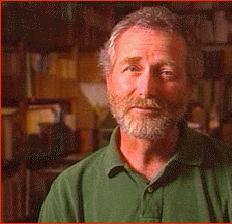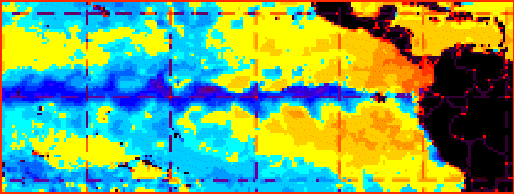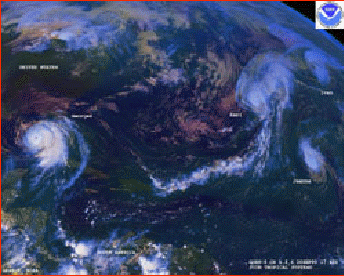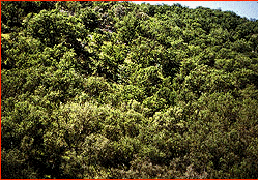 Mike
McPhaden
Mike
McPhadenGoodbye El Niño, Hello La Niña
By Mark Hoover
 Mike
McPhaden
Mike
McPhadenThe numbers are in. A recently released NOAA review confirms that the latest incarnation of El Niño was, indeed, the weather event of the century. Compared with the previous title-holder in 1982, the 1997 El Niño started earlier, grew faster, and amassed more energy. And then, in the parlance of the researchers who study it, "it got legs," maintaining its prodigious dimensions for months longer than in 1982.
Not content to just fade away, the El Niño in its endgame rewrote the record books again, as it receded at an unprecedented rate. El Niño's sea-surface temperature anomaly "just dropped like a rock. It was a hell of a signal," says Mike McPhaden, who directs NOAA's tropical Pacific monitoring program from his laboratory in Seattle. "We've never seen anything like it." He should know. Using one of the largest scientific instruments ever built -- the Tropical Atmosphere/Ocean Array, a network of buoy-mounted monitors stretching across the Pacific from Peru to Australia -- it's his job to watch for changes in that swath of the Pacific that is the womb of Earth's weather.
 Pool
of cold water (blue) off coast of South America.
Pool
of cold water (blue) off coast of South America.But now, finally, El Niño is gone, and as winter approaches, people around the world can breathe a collective sigh of relief...right? Unfortunately not.
True, the giant pool of abnormally warm water in the tropical Pacific that made last year's weather so difficult has gone away. But in its place, an abnormally cold pool of water has appeared, and it seems to have its own mischievous agenda. The hot and cold extremes are both avatars of the El Niño phenomenon, more properly called ENSO, or El Niño-Southern Oscillation, a name that reflects its dual nature.
El Niño's dramatic turnabout may portend yet another year of devastating weather ahead. As El Niño has transformed itself with lightning speed into its own opposite, the past year's weather disruptions may have been queued up to be played again, but with a twist; what was baked will be frozen, what was drenched will be parched, what was spared will be slammed. This "cold phase" sometimes brings weather that is the mirror image of El Niño.
It's not a perfect symmetry, points out Michael Glantz, of NOAA's National Climate and Atmospheric Research center in Boulder, Colorado. The mechanics of El Niño's cold cycle are fundamentally different from the warm cycle. "The rule of thumb is that the cold events don't get as cold as the warm events get warm. If you heat the ocean, you get lots of rain, way above normal. But if you cool the ocean, the most that happens is you shut off the rain. Once it's shut off, you can't get negative rain."
Still, even Glantz thinks this year may be exceptional. "The other shoe may be about to fall," he says. "Together, a strong El Niño and a strong La Niña can pack a climatological one-two punch second only to the change of seasons as a shaper of Earth's weather." Warning signs are already abundant. Consider the following:
During a May and June that seemed more like August, much of the US sizzled for weeks in temperatures 10, 20, even 30 degrees above normal.
 Hurricane
Georges, Sept. 26, 1998 ·http://www.pbs.org/wgbh/nova/elnino/anatomy/georges.html
Hurricane
Georges, Sept. 26, 1998 ·http://www.pbs.org/wgbh/nova/elnino/anatomy/georges.htmlThe Southern plains and the Southeast broiled all summer long under record heat. Texas and New Mexico in particular were hit by relentless strings of plus-90 and plus-100 degree days throughout June, July, and well into August. Rain was sparse, and crop losses quickly mounted.
Florida, wracked earlier in the spring by a rash of tornadoes, was next blackened by fires consuming its dried-out forests and grasslands as the rains failed in early summer. Although the rains finally returned, so did the threat of a hyperactive hurricane season.
The Atlantic hurricane season got off to an early start, and changes in upper-level winds over the Atlantic have made conditions ideal for hurricane formation. NOAA's Mississippi-based Hurricane Hunter storm fliers have stayed on alert as the warm waters off the African coast have generated tropical depressions like clockwork every three or four days.
The year of torrential El Niño rain along the Pacific coast of South America ended in late spring. Taking its place is the haunting specter of a year of drought. It may easily be a full year before a single drop of rain falls in parts of coastal Chile.
In June, fires burning out of control in drought-stricken central
Mexico created massive clouds of acrid smoke, easily visible from
space. Part of the burned area  was
a critically important biodiversity reserve, a last stand for
numerous endangered species. Each day of fire brought extinctions.
Then, like a flipped switch, torrential rains came late in the
summer, and brought a new nightmare: flooding. The burnt land was
further scarred by erosion, without plants to soak up the water. Many
people died as rivers left their banks and inundated surrounding lands.
was
a critically important biodiversity reserve, a last stand for
numerous endangered species. Each day of fire brought extinctions.
Then, like a flipped switch, torrential rains came late in the
summer, and brought a new nightmare: flooding. The burnt land was
further scarred by erosion, without plants to soak up the water. Many
people died as rivers left their banks and inundated surrounding lands.
California may face a fire peril of its own. El Niño rains stimulated lush growths of desert brush (called chaparral, right) on coastal mountainsides. Now, La Niña threatens a desiccating drought that will turn the overgrowth into a tinderbox by late autumn. Uncontrollable fires are possible, perhaps likely. There's more: chaparral ash leaves behind a waxy film on the soil, which will prevent winter rains from soaking in, resulting in flash floods.
So when can when we expect the tropical Pacific to return to normal? The surprising answer is basically, never. Normal is an average, but averages don't tell us much about actual conditions. If you stand with your feet frozen in a block of ice and your head in a pizza oven, your "average" body temperature might be 98 degrees, but you will be not survive. Likewise, although we know that year-in, year-out, the tropical Pacific on average is neither overly warm nor overly cold, there are very few times when, like Goldilocks' porridge, it's "just right." Most of the time, tropical ocean temperatures and currents are see-sawing in slow motion toward one extreme or the other, in a natural and recurrent cycle that takes years to complete. "We have to stop thinking of El Niño as an event, and start thinking of it as part of the Earth's breathing," says Princeton's George Philander. "It's as natural for the Earth to have El Niño as it is for a bell to ring." In a word, it's normal for the ocean to be abnormal.
Just as morning gives way to afternoon, then to night, then to morning once again, El Niño always gives way to the next part of its cycle -- and so sets up the conditions for its eventual return. In 1985, Philander coined a name for this "next part" of El Niño, calling it La Niña, or "Little Girl" to go with El Niño's "Little Boy." The name stuck.
The La Niña half of the phenomenon is even less understood than the El Niño half, in part because something has suppressed La Niña formation for the past 20 years -- precisely during the time instruments capable of monitoring it were developed and deployed. Scientists want to find out what that "something" is, especially because that "something" seems to be loosening its hold, indicating long-term changes in the climate system. Some think global warming may be involved; some think a larger oscillation involving the entire ocean is to blame. No one can say yet.
Whether it's a boom or bust, one thing can be said with certainty about the upcoming La Niña; it's going to crush a lot of cherished theories. With a dozen or more computer models predicting everything from Armageddon to a no-show, "its time for natural selection to do a little weeding of our theories" says McPhaden. As happened with the models that tried to foresee El Niño, there will be some predictions right on the money, and some just plain wrong.